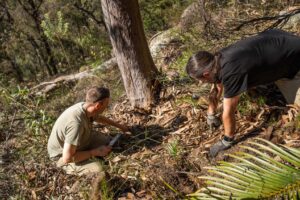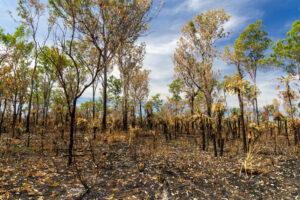
Saving cycads from extinction in botanic gardens
By James A. R. Clugston and Scott Yates
Cycads are a charismatic group of plants with a lineage that dates back more than 250 million years. With around 370 currently recognised species in 10 genera split between two families (Cycadaceae and Zamiaceae), they are diverse and have a strong pantropical distribution.
Resembling palms, cycads are cone bearing and are grouped with the gymnosperms. The enigmatic nature of cycads means they are a perfect choice in botanic gardens and private collections, as many species are aesthetically pleasing whilst simultaneously having great importance for education and science. The attractive glaucous foliage, interesting characteristics, and rarity of some species, particularly in the genus Encephalartos, hold great appeal for collectors. This has led to many cycad species being removed from their habitat, which combined with habitat fragmentation, climate change and extinction of pollinators, now means more than 60% of cycad species around the world are threatened with extinction, which is higher than any other group of plants (IUCN 2021).

For cycads, their rarity and scientific importance makes them the ideal candidates for ex-situ conservation, but with seeds that are recalcitrant (not lasting more than two years) seed banking is not an option. This means that living collections within botanic gardens are the only viable option for conservation. Botanic Gardens of Sydney has collections at the Royal Botanic Garden Sydney and the Australian Botanic Garden Mount Annan. This is Australia’s largest and most well documented cycad collection, encompassing all 10 Genera, over 150 species and more than 1,500 individual plants.
Australia is a biodiversity hotspot for cycads and has 83 (~22%) of the 371 currently recognised species in four genera Cycas (38), Macrozamia (41), Bowenia (2), and Lepidozamia (2). However, despite the diversity of cycads in Australia, few species are regularly cultivated in botanic gardens and as such, these collections do not represent the genetic diversity found in the wild (Clugston et al. 2022). Genetic diversity is important to understand when considering the multitude of threats posed on wild populations such as uncontrolled burning and land clearing.
Recent research at Botanic Gardens of Sydney has highlighted the importance of living collections and their role in ex-situ conservation (Clugston et al. 2022). However, effective conservation requires a close working relationship across teams including science, horticulture, and education. Developing these close working relationships has allowed us to increase the scientific and horticultural value of the cycad collections at the Gardens, whilst creating compelling and scientifically accurate interpretation and engaging media content. The recent appointment of a Horticultural Cycad Specialist role is also helping to ensure the continued survival and longevity of the collection.

In curating this collection, we have found it to be vital that accurate plant records are maintained, and recording information such as sex and phenological data is important when tracking cone production for the purposes of propagation. This will allow us to predict when male cones are ready for harvesting (pollen collection and banking) and female cones are ready for pollinating or seed collection, with the resultant seeds and seedlings able to be shared with other botanic gardens around Australia.
Another priority for Botanic Gardens of Sydney is safeguarding our native cycad species with well curated collections, and botanic gardens have the ability to represent the genetic diversity of wild populations (Griffith et al. 2015) to create genetically diverse assurance colonies. This, coupled with the ability to genetically determine the sex of cycad seedlings, further allows us to not only maintain diversity, but to create an ex-situ collection that better represents the sex ratio in natural populations (Clugston and Kenicer 2022).
At Botanic Gardens of Sydney, we are also actively collecting seeds, seedlings, herbarium specimens, and DNA samples from populations of native cycad species, that are at risk throughout Australia with an aim to create a genetically diverse ex-situ population to help protect plants in the wild. To do this, we are partnering with other leading botanic gardens and leading the BGCI Global Conservation Consortium for Cycads in Australia and the IUCN Cycad Specialist Group. The primary aim for the cycad collections at the Gardens is not only to focus on expansion, but to become a world leader in cycad conservation and horticultural excellence to help protect these unique and rare plants from extinction.
References
Clugston, J. A.R., and Kenicer, G. J. (2022). Sexing cycads—a potential saviour. Nature Plants, 1-2.
Clugston, J. A. R., Ruhsam, M., Kenicer, G. J., Henwood, M., Milne, R., & Nagalingum, N. S. (2022). Conservation genomics of an Australian cycad Cycas calcicola, and the Absence of Key Genotypes in Botanic Gardens. Conservation Genetics, 1-17.
Griffith, M. P., Calonje, M., Meerow, A. W., Tut, F., Kramer, A. T., Hird, A., & Husby, C. E. (2015). Can a botanic garden cycad collection capture the genetic diversity in a wild population? International Journal of Plant Sciences, 176(1), 1-10.
IUCN (2021) The IUCN Red List of Threatened Species. Version 2023-1. https:// www.iucnredlist.org. Accessed 02 Feb 2023.
Main photo: The spectacular colour and leaf details of the majestic Encephalartos horridus growing in the living collection of the Royal Botanic Garden Sydney, Australia (Image supplied by Royal Botanic Gardens Sydney)
